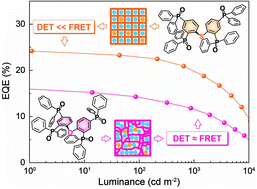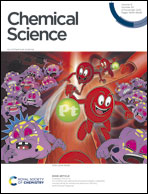Weaving host matrices with intermolecular hydrogen bonds for high-efficiency white thermally activated delayed fluorescence†
Abstract
A thermally activated delayed fluorescence (TADF) white organic light-emitting diode (WOLED) holds great promise for low-cost, large-scale lighting applications. Nevertheless, manipulating exciton allocation in a white TADF single layer is still a challenge. Herein, we demonstrate that the exciton kinetic process of dually doped white TADF films is strongly dependent on the grid regularity of the host matrix. Intermolecular hydrogen bonds (IHBs) are used to weave the matrices of two host molecules DPEQPO and DPSQPO featuring four phosphine oxide (PO) groups and different IHB orientations. The DPSQPO matrix forms regular grids to uniformly disperse and separate dopants, while DPEQPO exhibits chaotic IHBs, in turn inducing a heterogeneous dopant distribution. As a consequence, in both photoluminescence and electroluminescence processes, in contrast to DPEQPO hosted systems with comparable singlet Förster resonance energy transfer and triplet Dexter energy transfer, DPSQPO provides a FRET-predominant exciton allocation between blue and yellow dopants, which markedly suppresses triplet quenching and improves the white color purity, resulting in a state-of-the-art external quantum efficiency up to 24.2% of its single-emissive-layer pure-white TADF diode, in contrast to 16.0% for DPEQPO based analogs. These results indicate the significance of host engineering for exciton kinetics and suggest the feasibility of host grid design for developing high-performance TADF lighting.



 Please wait while we load your content...
Please wait while we load your content...